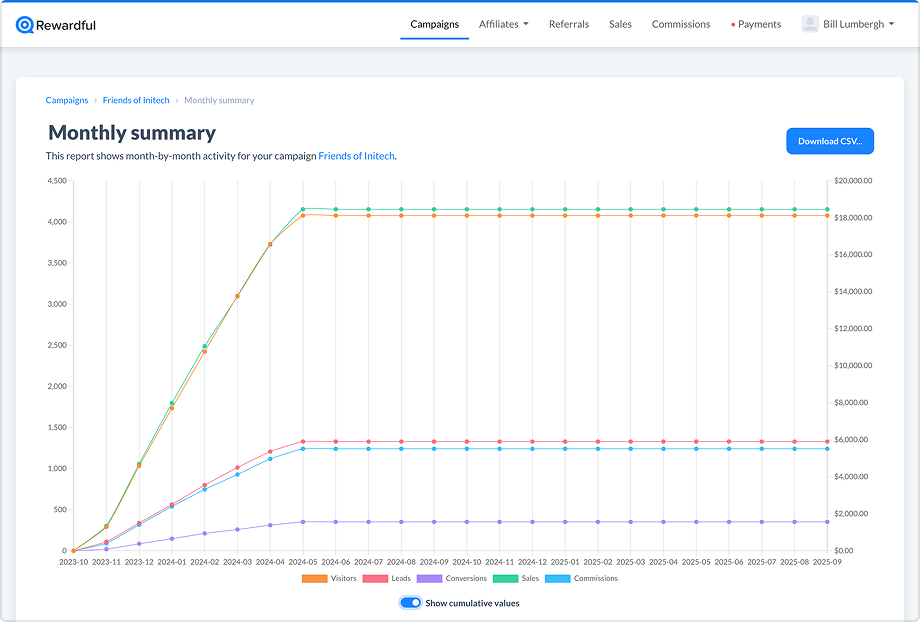Accurate affiliate marketing tracking goes beyond simply identifying your top performers and calculating commissions. It unlocks valuable insights into the customer journey, allowing you to optimize every touchpoint and maximize your affiliate program's effectiveness.
Let’s explore various SaaS affiliate tracking techniques and decide which works best for your situation. We’ll also give you tips on how to implement and optimize your affiliate tracking methods.
Why Choosing the Right Affiliate Marketing Tracking Methods Is Vital for SaaS
SaaS companies often have a long and windy customer lifecycle. By monitoring each checkpoint and measuring it with the right affiliate metrics, you can understand which strategies work and which don't.
Pro tip: Discover 10+ important affiliate marketing metrics every affiliate manager should focus on.
This gives you a better understanding of which affiliates drive not just clicks, but meaningful engagements and long-term subscriptions. With this data in your hands, you can:
- Identify top-performing affiliates and strategies.
- Allocate resources efficiently.
- Make improvements to your commission structures.
- Boost your overall ROI.
9 Must-Know Affiliate Marketing Tracking Techniques
You can double down on one tracking method for affiliate marketing, or combine them for more accurate and in-depth results. Whichever SaaS affiliate tracking techniques you choose, make sure that you know why they're the best ones for your program.
1. Pixel Tracking
One of the most popular affiliate marketing tracking methods is pixel tracking. It involves embedding a small code into your website or emails to monitor user behavior and conversions.
When someone visits your site, this pixel returns data to your system, recording actions like page views, sign-ups, or purchases. This provides valuable real-time data, allowing you to see what users do as it happens. Pixel tracking is straightforward to implement and gives you precise tracking data on specific actions.
Tips for success:
- Avoid slowing down your site: Regularly test your site's performance to ensure the pixel doesn’t impact speed.
- Combine with other tracking software: Use heatmap tools alongside pixel tracking to get a comprehensive view of user interactions to optimize their journey.
2. Cookie Tracking
Cookies are small files stored on a user’s device when they visit your site, enabling you to track their behavior over time. For instance, when someone clicks an affiliate link, a cookie is placed on their browser, which will impact their activities and credit the connected affiliate if a conversion happens. Cookie tracking is particularly useful for monitoring long-term user behavior, as it can store information for days or weeks.
Tips for success:
- Set the right duration: Choose a cookie duration that matches your needs. For SaaS businesses, 30-90 days is often ideal because it provides enough time to track user behavior while remaining relevant.
- Educate affiliates: Make sure your affiliates understand how cookie tracking works, its limitations, and the terms and conditions applied. This will help them use it effectively, set realistic expectations, and be compliant.
3. JavaScript/First-Party Cookie Tracking
JavaScript/first-party cookie tracking uses JavaScript to set cookies directly on your domain. When users interact with your site, these cookies are set and stored by your domain, making them less likely to be blocked by browsers. JavaScript/first-party cookie tracking is more dependable than third-party cookies, ensuring consistent tracking data.
Tips for success:
- Follow privacy laws: Check that your use of cookies complies with privacy regulations. This prevents legal issues and maintains user trust.
- Monitor performance: Regularly verify your tracking functions correctly to ensure you capture all the necessary data.
Cookie Tracking vs. JavaScript/First-Party Cookie Tracking
They may sound similar, but there is a difference. In simple terms, cookie tracking involves placing small files (cookies) on a user’s device when they click an affiliate link. It tracks their behavior over time to attribute conversions. Javascript/First-Party Cookie Tracking, on the other hand, uses JavaScript to set cookies directly on your domain. This is a more reliable affiliate tracking technique since they are less likely to be blocked by browsers.
Keep in mind that Google and other browsers are phased out of third-party cookies, which are set by domains other than the one the user is visiting, due to privacy concerns. This makes first-party cookies, set by your domain, increasingly important for accurate affiliate tracking and compliance with privacy regulations.
4. SubID Tracking
SubID tracking allows affiliates to add unique identifiers to their links, helping you track the performance of specific campaigns or strategies. Affiliates include unique SubIDs in their links, tracking which campaigns drive conversions. You'll get detailed data on affiliate performance, empowering you to optimize specific parts of your campaigns.
Tips for success:
- Create a standardized structure: Develop a consistent format for SubIDs to make data analysis easier. This could mean setting a naming convention, including campaign names, dates, or specific strategies.
- Link to CRM: Integrate SubID data with your CRM to get a full view of customer journeys and calculate lifetime value.
5. Server-Side Tracking
Server-side tracking involves recording user actions directly by your server rather than relying on the user's browser to send data. When a user performs an action on your website, like clicking a button or making a purchase, your server captures this action. This method avoids issues with browser settings or ad blockers that can interfere with client-side tracking, making your affiliate tracking data more reliable.
Tips for success:
- Build robust infrastructure: Make sure your server can handle the additional tracking load without affecting performance.
- Combine with client-side tracking: Use both methods for the most accurate data. Server-side tracking is excellent for critical conversions, while client-side methods capture broader user behavior insights.
6. Server-To-Server Tracking
Server-to-server tracking involves direct communication between your server and the tracking server to record user actions. When a user acts on your website, your server sends the details directly to the tracking server. This process bypasses the user's browser, which means that data is transmitted and recorded in real-time without being affected by browser settings or ad blockers.
Tips for success:
- Use secure protocols: Secure protocols protect your data during transmission from interception.
- Audit regularly: Periodically check that your tracking setup is functioning correctly to maintain accuracy and reliability.
7. FTP (File Transfer Protocol) Tracking
FTP (File Transfer Protocol) tracking involves using FTP to upload transaction data from your system to an FTP server. When a transaction occurs on your website, such as a sale or registration, your system generates a file with the transaction details and uploads it to an FTP server. These files can then be processed and analyzed to give you insights into user behavior and performance metrics.
Tips for success:
- Automate uploads: Set up automated processes to regularly upload transaction data to the FTP server. Automation ensures consistency and saves time.
- Check data accuracy: Verify that the uploaded data is complete and accurate by cross-checking with other methods. Regular checks help prevent errors and data loss.
8. Promo Code Tracking
Another well-known SaaS affiliate tracking method is promo tracking. Promo code tracking uses unique codes that affiliates distribute to track sales. Affiliates share these unique promo codes with their audience. When a user redeems one of these codes during a purchase, the sale is attributed to the affiliate who provided the code. It is simple and effective and works for both online and offline promotions.
Tips for success:
- Generate unique codes: Create distinct promo codes for each affiliate to ensure accurate sales tracking.
- Monitor usage: Regularly check promo code redemption rates to ensure they are being used correctly and effectively.
- Combine methods: Use promo code tracking alongside other methods like pixel tracking to get a more comprehensive view of affiliate performance.
9. Direct Tracking
Direct tracking uses unique URLs to track affiliate-generated traffic and conversions. Affiliates use these unique URLs that include specific identifiers. When users click these links, their actions are tracked and attributed to the affiliate.
Tips for success:
- Create unique URLs: Generate specific tracking URLs for each affiliate to ensure accurate tracking of their traffic.
- Monitor performance: Review each URL's performance regularly. This will help you optimize your campaigns and improve results.
- Use multiple methods: Combine direct tracking with SubID tracking for detailed insights. This gives you a deeper understanding of affiliate performance.
How Affiliate Marketing Tracking Methods for SaaS Are Changing in 2025
The affiliate tracking landscape is evolving rapidly to address privacy concerns while maintaining accuracy in an increasingly complex digital ecosystem.
Key transformations in SaaS affiliate tracking for 2025 include:
- Cookie Persistence: Despite earlier predictions, third-party cookies remain in use for 22.2% of affiliate events on Chrome following Google's policy reversal.
- Server-to-Server Adoption: S2S tracking has reached 50% adoption in key sectors like Department Store, FMCG, and Home & Garden, offering more reliable measurement without browser limitations.
- Privacy-First Solutions: Fingerprint and blockchain-based tracking are gaining traction as privacy-compliant alternatives to traditional cookies.
- AI-Enhanced Attribution: Artificial intelligence is revolutionizing tracking with advanced attribution models that more accurately measure affiliate contributions across complex customer journeys.
- Social Platform Integration: Major platforms like TikTok and Meta have integrated native affiliate tracking capabilities, streamlining measurement for influencer-driven campaigns.
- Hybrid Approaches: Most successful SaaS companies now employ multiple tracking methods simultaneously to ensure comprehensive coverage and minimize data loss.
Adopt Rewardful—Powerful Affiliate Tracking Software
Accurate affiliate tracking is the backbone of a successful program. But beyond methods, the right affiliate software makes all the difference. Rewardful streamlines affiliate tracking, empowering you to unlock valuable insights and optimize your program for maximum impact.
We help you monitor affiliate performance through links and coupon code tracking, allowing you to gain insights into your popular products and services, see how your affiliates perform, and help them grow even further.
Experience our powerful SaaS affiliate tracking solution. Sign up now and get a 14-day FREE trial!













